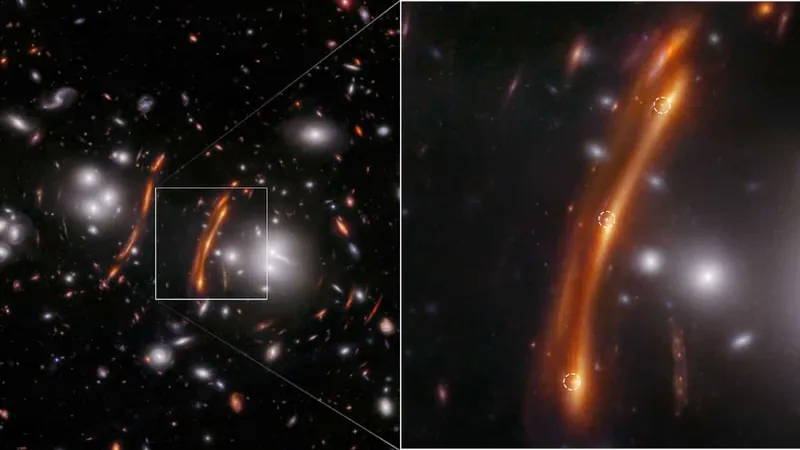
A Cosmic Wonder: JWST Captures the Same Supernova Thrice Due to Bizarre Spacetime Quirk!
2024-10-03
The James Webb Space Telescope (JWST) has unveiled a breathtaking cosmic phenomenon—one supernova observed three times in a series of images, all thanks to an extraordinary twist in the fabric of spacetime. This captivating effect is a result of gravitational lensing, a natural occurrence where light is bent around massive cosmic structures.
Gravitational lensing occurs when the immense mass of objects, such as black holes or clusters of galaxies, distorts the surrounding spacetime. The regions responsible for this bending, known as gravitational lenses, act much like optical lenses, allowing us to see distant objects in the universe more clearly.
In this particular observation, the gravitational lens originates from a galaxy cluster located in the Ursa Major constellation, designated PLCK G165.7+67.0, or simply G165. The combined gravitational force of the galaxies within this cluster dramatically bends and focuses light from even more distant sources, enhancing their visibility from Earth.
Brenda Frye, an astronomer at the University of Arizona and co-author of the study, explained the phenomenon: “To achieve three images, the light travelled along three different paths. Since each path had a different length, and light travelled at the same speed, the supernova was imaged in this Webb observation at three different times during its explosion.”
The astronomy community eagerly anticipates further revelations, as only preliminary findings have been published. A more comprehensive study detailing this supernova is set to be released on the preprint server arXiv, making it a highly anticipated piece of research.
What Makes This Supernova Special?
This particular supernova is a stunning reminder of the life cycle of stars, often marking their death throes in brilliant explosions. Researchers were thrilled to observe that the gravitational lensing in this case magnified the light from the supernova, essentially creating three distinct images of the same cosmic event stretched across the sky.
The JWST utilized its Near-Infrared Camera (NIRCam) to capture the galaxy cluster and the supernova during observations in March, April, and May of last year. Notably, the galaxy cluster G165 is situated about 3.6 billion light-years away from Earth, while the supernova itself is even further afield, revealing an ancient cosmic relic from the past.
The gravitational lensing effect produced an arc-like shape as it flattened the galaxy cluster, creating three points of light along the arc—each representing the same supernova, yet observed at different temporal angles. Frye illustrated this phenomenon with a clever analogy: “Think of it like looking into a three-panelled vanity mirror. Each reflection shows a different moment of action—one with a comb being lifted, another while the hair is being combed, and a third where the comb is being put down.”
As scientists continue to delve into this extraordinary data, the insights gained from this observation could further deepen our understanding of the cosmos, ultimately illuminating the complex interplay between gravitational forces and the lifecycle of stars.
Stay tuned as more exciting findings unfold from this cosmic marvel!



 Brasil (PT)
Brasil (PT)
 Canada (EN)
Canada (EN)
 Chile (ES)
Chile (ES)
 España (ES)
España (ES)
 France (FR)
France (FR)
 Hong Kong (EN)
Hong Kong (EN)
 Italia (IT)
Italia (IT)
 日本 (JA)
日本 (JA)
 Magyarország (HU)
Magyarország (HU)
 Norge (NO)
Norge (NO)
 Polska (PL)
Polska (PL)
 Schweiz (DE)
Schweiz (DE)
 Singapore (EN)
Singapore (EN)
 Sverige (SV)
Sverige (SV)
 Suomi (FI)
Suomi (FI)
 Türkiye (TR)
Türkiye (TR)